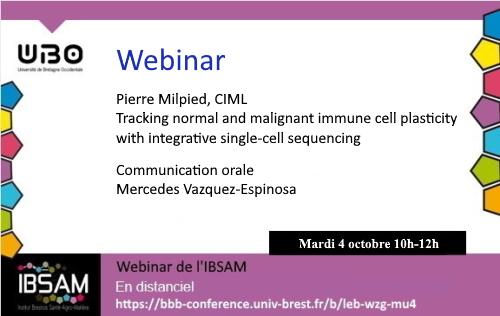
Pierre Milpied, CIML, Marseille
Tracking normal and malignant immune cell plasticity with integrative single-cell sequencing
In immune responses to vaccines, pathogens, or auto-antigens, B cells and B-helper T cells undergo significant molecular and cellular evolution (e.g. B-cell receptor (BCR) affinity maturation in germinal centers (GC), plasma cell differentiation, and T follicular helper (TFH) cell activation). Genetic, and epigenetic alterations may transform B and T cells into malignant clonal expansions that give rise to lymphomas. In my lab, we use integrative single-cell sequencing to study the dynamics and plasticity of normal and malignant B and T cells in normal immune responses and lymphomas. In my seminar, I will introduce the methods that we use for single-cell sequencing and data analysis, then describe our most recent work on the plasticity of malignant B cells in follicular lymphomas, and malignant T cells in angioimmunoblastic T cell lymphomas.
Mercedes Vasquez-Espinosa
Separation and quantification of main capsaicinoids in pepper by liquid chromatography coupled to high resolution accurate-mass ion mobility mass spectrometry (LC-HR/AM-IM-MS)<
Pepper is one of the most valuable horticultural crops worldwide due to its organoleptic properties, its richness in bioactive compounds and its strong antioxidant capacity. Capsaicinoids are the secondary metabolites responsible for the spicy sensation. They have exhibited a large number of properties of great importance for human health such as anticancer, anti-inflammatory, analgesic or antimicrobial1. Recently, ion mobility mass spectrometry has shown an enormous potential to separate strongly related compounds in complex samples2. When this technique is coupled with LC-HR/AM-MS, the separation power is greatly increased, providing a high potential for the separation of isomers and improving then further the selectivity of the method3.
The main objectives of this collaboration within the SEA-EU consortium were to separate and quantify the main capsaicinoids present in a selection of pepper varieties and, eventually, identify isomers. Liquid chromatography coupled to our SYNAPT-XS instrument (UBO, Mass Spectrometry plateform) achieved these goals for several capsaicinoids. HR/AM-IM-MS are now routine with the latter instrument at UBO. Capsaicine (C) and Dihydrocapsaicine (DHC has an extra unsaturation on the carbon chain as compared to C) were identified, separated, and quantified (the concentrations were 70.30 ppm and 41.83 ppm for C and DHC, respectively). This demonstrates the very high sensitivity achieved with our instrument despite the very high sample complexity (down to ppb) (Figure 1). Other minor capsaicinoids were also detected. Some of our results suggest the presence of several isomers of different types depending on the pepper variety. A more detailed analysis is actually on track on our instrument to confirm those results4.

Figure 1: IMS Mobilogram of capsaicin (C) and dihydrocapsaicin (DHC) on the left and IMS calibration curves on the right. Results were obtained by LC-HR/AM-IM-MS SYNAPT XS at UBO platform.
Références.
1- M.K. Meghvansi et al. J. Ethnopharmacol., 2010, 132, 1-14.
2- E. Brinke, A. Arrizabalaga-Larrañaga, M.H. Blokland. Anal. Chim. Acta, 2022, 1222, 340039.
3- Y. Yamaguchi, W. Nishima, S. Re, Y. Sugita. Rapid Commun. Mass Spectrom., 2012, 26, 2877-2884.
4- U. Schweiggert, R. Carle, A. Schieber. Anal. Chim. Acta, 2006, 557, 236-244.


